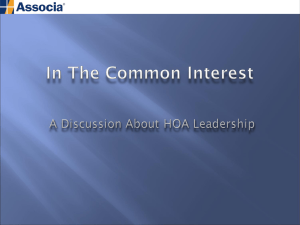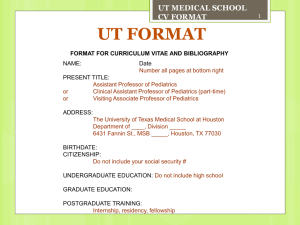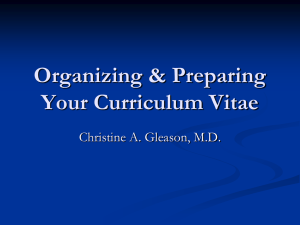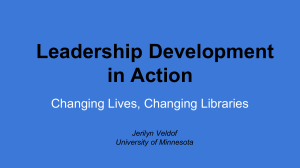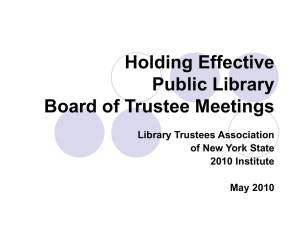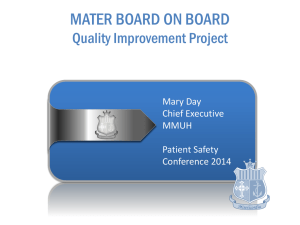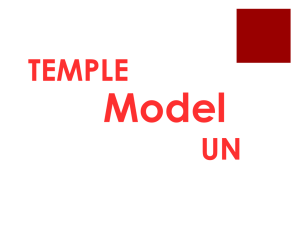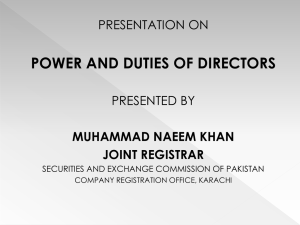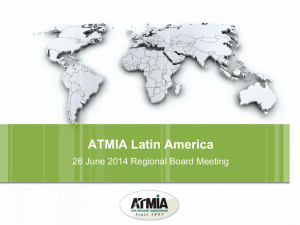KFAI Strategic Plan
advertisement
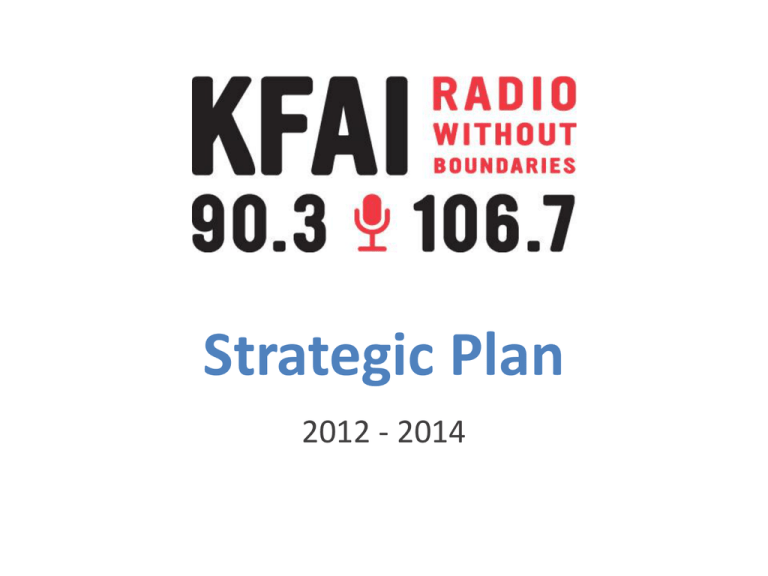
Strategic Plan 2012 - 2014 Mission Statement KFAI is a volunteer-based community radio station that exists to broadcast information, arts and entertainment programming for an audience of diverse racial, social and economic backgrounds. By providing a voice for people ignored or misrepresented by mainstream media, KFAI increases understanding between peoples and communities, while fostering the values of democracy and social justice. Our Organization Since 1978, KFAI has been the voice of the community. The station has been and continues to be the Twin Cities’ source for adventurous and innovative music, news, arts, and community programs. The history of KFAI lives within the thousands of volunteers that have given their time and the listeners who have tuned in. Our Organization Since 1978, KFAI has been the voice of the community. The station has been and continues to be the Twin Cities’ source for adventurous and innovative music, news, arts, and community programs. The history of KFAI lives within the thousands of volunteers that have given their time and the listeners who have tuned in. A Brief History of KFAI • Founding: – KFAI, Fresh Air Radio, went on the air at 90.3FM on May 1, 1978, after five years of paperwork and other legal entanglements. The station’s first studios were in the belfry of Walker Community Church and the antenna sent out a mighty 10 watts from the roof of the Seward Co-op. • 1980’s – In 1984, KFAI increased its power to 125 watts and moved its transmitter to the Foshay Tower in downtown Minneapolis, greatly expanding the coverage area. The station later added a Saint Paul translator at 106.7FM in 1994. – KFAI moved out of the Walker Community Church in 1986 to new studios above Butler Drug at the intersection of Lake and Bloomington in Minneapolis. • 1990’s – In 1991, KFAI moved its studios to its current home in the historic Bailey Building on the West Bank. • 2000’s – 2001 saw the dedication of KFAI’s renovated studios. The renovation increased studio space from two working studios to six. • Today – KFAI broadcasts from high atop the IDS building and will soon be broadcasting in crystal clear digital. Strategic Plan 2012-2015 Strategic Plan Process Community Input SPLAN Process Strategic Plan (high level) Our Key Priorities Our Strategic Framework Action Plan (implementation level) Our Initiatives Our Success Measurements Our Roles/Responsibilities Our Base Assumptions We need to grow our organization to meet our mission statement We need to attract smart, creative people in order to develop relevant and interesting programming… We need to increase our community network to drive discussion and build smart ways of making progress toward our mission… We believe our mission is relevant to more people than we currently attract Setting the Table • Define our values – – – – – We embrace our uniqueness We are inclusive of the diversity of our community We are locally-focused and produced, with a global view We are community and volunteer driven We provide access and a voice for the underrepresented • Put strategies into 4 big picture priorities – – – – Building a structure to frame our strategies Aspirational directions for the organization to pursue Leveraging input, language and spirit of the organic process to-date Many more from which to choose • Board alignment and measurement Strategic Priorities • Expand the connection of our mission to a larger audience • Catalyze new collaborations, programs, and organizations that grow new and existing audiences • Convene programmers, journalists and artists to drive leadership and innovation within arts and media • Build a strong and growing organization Priority: How do we expand the connection of our mission to a wider audience? • Building and leveraging new and existing partners to reach largest audience possible and expand our mission impact – – – – Funders Service / arts / media organizations Schools Governments • Utilize technology to expand reach and impact for new and existing audiences – Increase audience participation with our mission – Increase awareness and traffic to KFAI.org by developing/executing a unified social media strategy – Lower barriers-to-access of KFAI programs • Expand existing an organizational marketing plan Priority: How do we catalyze new collaborations, programs and organizations that grow new and existing audiences? • Create a strong content development and production support structure for programmers, journalists, and artists – Share expertise and knowledge (incl. content development) – Provide a suite of tools (technology, equipment, etc.) – Access to potential funders • Develop training and educational services for programmers, journalists, and artists that expand their capacities to do great work – Workshops • Ex. Licensing of content, education (writing for broadcasting) – Training seminars • Ex. Building awareness among audience members Priority: How do we convene programmers, journalists, and artists to drive leadership and innovation within arts and media • Utilize our media, partnership, and community network to bring power to issues – Become an agenda-setter and drive discourse for issues related to those underrepresented by mainstream media – Create agendas relevant to programmers/journalists/artists to address needs and build solutions – Research and data-driven influence Priority: Build a strong and growing organization • Diversify and grow revenue – Build long-term fundraising development plan – Maximize earned revenue (new services, methods of delivery, partnerships) – Develop innovations in fundraising • Maximize human capital for greatest mission impact – Effective volunteer management – Ensuring opportunities for employee training & development – Structured process of community input and new initiatives • Provide an infrastructure sufficient to allow staff to achieve organizational goals – Create a capital expenditure plan • Ensure the highest quality programming reflecting our values – Build a transparent program evaluation system – Enhance and increase youth initiatives Board of Directors Committee Realignment Realigning the Board • Align Board committees to the SPLAN – One committee per strategic priority, so the plan is always front and center in every meeting – Institutionalizes that we succeed and fail together, removing silos – Provides a home for ideas and innovation – ED leads measurement discussions with each committee – Dashboard created to track progress quarterly Board Committees • The current functional committees (Executive, Finance, Governance & Nominations) will continue to exist and will have the same responsibilities. However, in order to insure no Board member becomes over-tasked, these committees will become smaller. – – – – Executive Committee: 4 – President, VP, Secretary & Treasurer Finance Committee: 2 + the Executive Director Governance: 3 Nominations: 3 • In order for the Board of Directors to focus their efforts on the Strategic Plan, each of the 4 strategic priorities will have a Board of Directors committee. Board Committees Structure Board of Directors Functional Committees Strategic Plan Committees Executive Committee Connection SPLAN Committee Finance Committee Catalyst SPLAN Committee Exec. Dir. STAFF Governance Committee Convening SPLAN Committee Nominations Committee Strong & Growing Org SPLAN Committee Who’s on Strategic Plan Committees? The make-up of each of the 4 Strategic Committees will be: • 3 to 4 board members with one serving as the chair of the committee • 1 staff member – Staff can only serve on one committee and cannot chair. – Committee term is one year. – A staff member can also serve as a subject matter expert • 2 or more volunteers – One year term – By invitation of the committee • Additional subject matter experts as needed – No mandatory term – Can be someone not currently associated with KFAI that has relevant knowledge or experience • Each Board of Directors member must serve on one of the 4 Strategic Committees – Due to the demands of Board work, there will be an exception to this rule for the Board of Directors President and the Treasurer (who serves on the Executive and Finance committees) How Do We Handle New Work? • In order to accommodate the amount of work that needs to be done and ensure enough “face” time for Board collaboration and feedback, we propose the following changes to the Board of Directors meeting schedule: – Meeting time, place and frequency remains the same as current – Alternate monthly meeting agenda between functional business and strategy – The Strategic Plan committees will also be expected to meet as necessary to achieve their objectives. These meetings are construed broadly – they could be by phone, email or collaborative editing via Google docs. • The Board meeting schedule is as follows: – Functional business meetings – January, March, May, July, September, November – Strategic plan meetings – February, April, June, August, October, December Board Committee Structure • Functional Business meeting agenda – – – – – – – Financials / pledge drive Audience metrics (Arbitron & website stats) Operations Marketing Governance & Nominations/elections when necessary SPLAN Dashboard No routine staff reports – Staff reports will still be done but board interaction will be through email and Google documents before every meeting. Any issues for substantive board discussion need to be added to the agenda before the meeting. • Strategic Plan meeting agenda – A 50 minute meeting with all Board members – 3 committees present a 10 minute check-in using the dashboard and any other relevant info. Check-in could be as simple as “all green light” or “here’s our problem area” or “we have some skill/assistance requests” – 1 committee will present a 20 minute full report to the board at each meeting. This means that each committee will do this every 4 months (3 times per year). – The remainder of the meeting will be broken up into small-group work Additional Notes • The Executive Director is responsible for overall delivery of the strategic plan and does not serve on any specific committee – The ED has an open invitation to any of the Strategic Plan committee meetings, but is not required to attend • The ED is involved in developing and monitoring metrics for measuring impact and progress of the Strategic Plan • The Strategic Plan and Board structure will be included in the Board Orientation program in January
